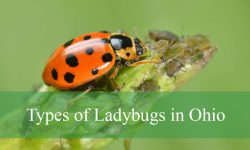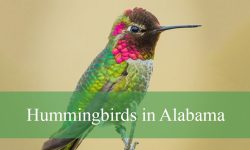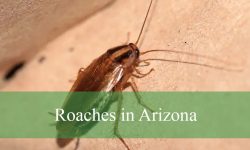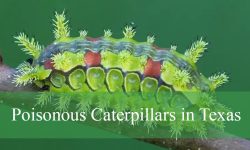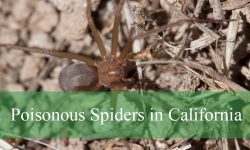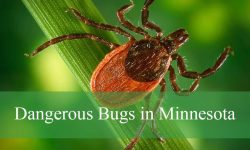Colorado is one of the best places in the western United States to watch hummingbirds. Every spring, these small, energetic birds return to the mountains, foothills, and plains to feed and breed. Their quick movements, bright colors, and constant activity make them a favorite among birdwatchers across the state.
The combination of Colorado’s mountain meadows, open woodlands, and wildflower-filled valleys creates perfect conditions for many hummingbird species. Some, like the Broad-tailed and Black-chinned Hummingbirds, stay through the summer to raise their young, while others, such as the Rufous and Calliope, pass through during migration.
Watching hummingbirds in Colorado offers a rewarding experience throughout the warm months. Their arrival signals the start of summer, and their departure marks the approach of fall. Each species adds something unique to the season, making every sighting special for those who take the time to look.
Types of Hummingbirds Found in Colorado
Broad-tailed Hummingbird (Selasphorus platycercus)
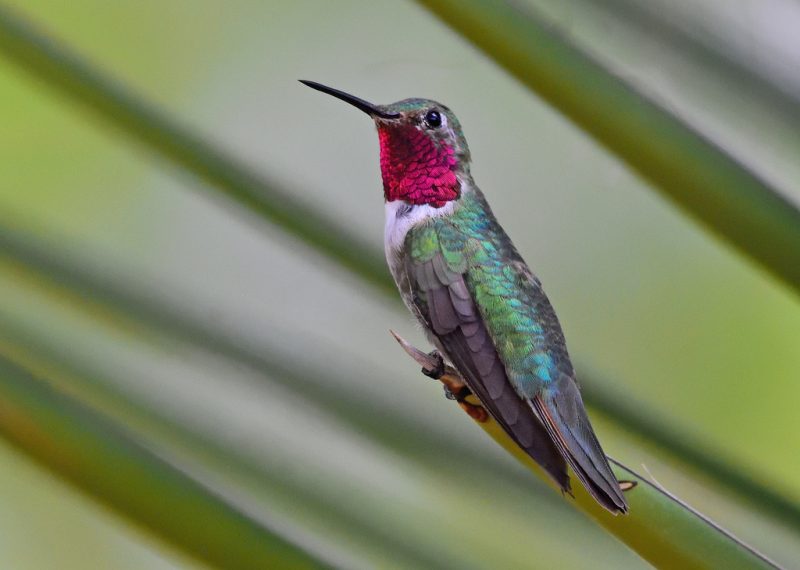
The Broad-tailed Hummingbird is one of the most recognizable and widespread hummingbirds in Colorado. Adult males can be identified by their glittering rose-red throat patch, known as a gorget, which contrasts beautifully against their green upperparts and whitish underparts. Females and juveniles, while less colorful, display greenish backs with buffy flanks and faint spotting on the throat. Their wings produce a high-pitched metallic trill in flight, a distinctive sound that makes identification easy even before you see them.
This medium-sized hummingbird measures about 4 inches in length with a wingspan of around 5 inches. They have long, straight bills adapted for sipping nectar from deep tubular flowers. In the bright mountain sunlight, males often hover in midair during territorial displays, flashing their iridescent throats to warn rivals or attract females. They are agile fliers, capable of rapid backward and forward movements, and often perform dive displays during courtship.
Broad-tailed Hummingbirds breed across the Rocky Mountains, thriving in montane meadows, aspen groves, and pine-oak forests. They prefer elevations between 6,000 and 10,000 feet, where wildflowers are abundant in summer. Females construct small cup-shaped nests from plant fibers, spider silk, and moss, often attached to low branches shaded from direct sunlight.
In Colorado, these birds arrive by late April and stay through early September. The best time to observe them is from June to August in the high country, especially in areas like Rocky Mountain National Park and the San Juan Mountains. During migration, they visit backyard feeders across the state before departing for their wintering grounds in Mexico and Central America.
Rufous Hummingbird (Selasphorus rufus)
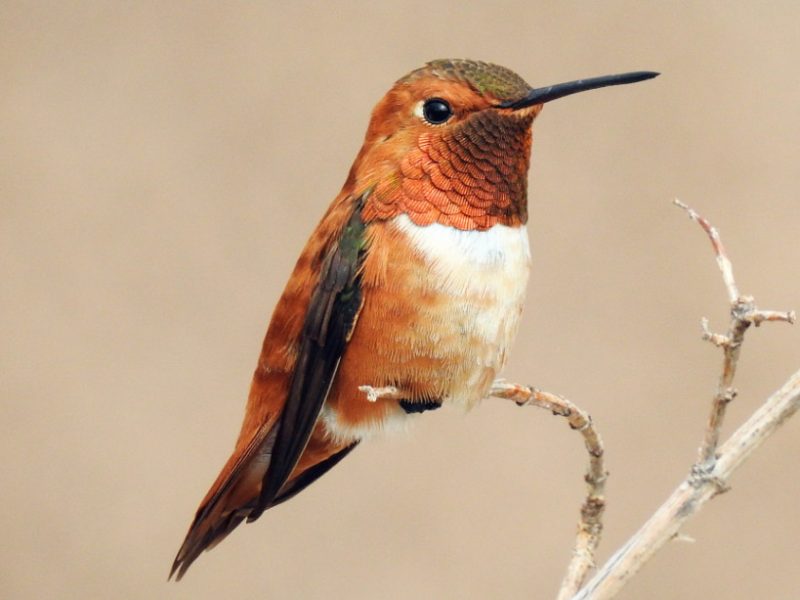
The Rufous Hummingbird is a small, fiery species famous for its aggressiveness and stamina. Males are striking with a brilliant orange back, rufous flanks, and an iridescent red gorget that gleams in sunlight. Females have green upperparts with rufous tones on the sides and tail, providing camouflage while nesting. Their short, buzzing flight calls often signal their presence long before they appear at flowers or feeders.
Measuring around 3.5 inches long, the Rufous Hummingbird is small but bold, defending feeding areas vigorously against much larger species. Their flight is rapid and direct, often punctuated with sharp dives and turns. Males perform dramatic U-shaped flight displays during courtship, producing a loud wing hum. Despite their feisty temperament, these hummingbirds are crucial pollinators of alpine and subalpine wildflowers.
In Colorado, Rufous Hummingbirds are primarily passage migrants. They breed in the Pacific Northwest and Alaska but travel through Colorado during their southbound migration in late July and August. During this period, they can be found across the state, especially in mountain meadows and foothill gardens, where they stop to refuel before continuing their journey.
The best time to observe Rufous Hummingbirds in Colorado is midsummer, particularly in the Front Range and San Juan regions. Their relentless energy and brilliant colors make them a favorite among birdwatchers. As fall approaches, they depart for wintering areas in southern Mexico, completing one of the longest migrations relative to body size of any bird in the world.
Calliope Hummingbird (Selasphorus calliope)
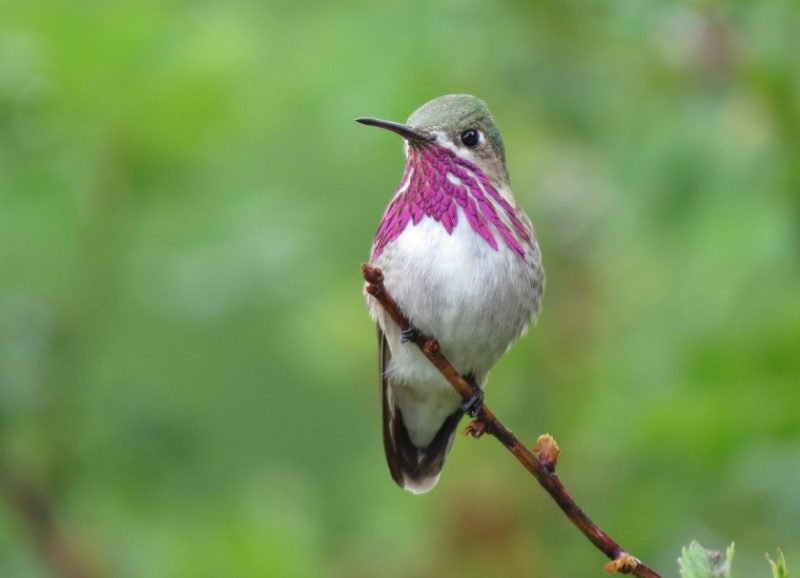
The Calliope Hummingbird holds the distinction of being the smallest bird in North America, measuring only about 3 inches long and weighing less than a penny. Males are unmistakable with a radiant magenta gorget formed by streaked feathers that fan outward, creating a starburst effect. Females, though less vivid, show greenish upperparts and buffy underparts with light spotting on the throat, giving them a delicate appearance.
Despite their small size, Calliopes exhibit surprising strength and determination. Their flight is swift yet controlled, and males often perform looping dive displays while producing a high-pitched buzz with their tail feathers. They are fiercely territorial, often chasing away larger hummingbirds from preferred flowers or feeders, proving that size is no measure of dominance in the hummingbird world.
In Colorado, Calliope Hummingbirds breed primarily in subalpine meadows, spruce-fir forests, and open mountain slopes. They favor elevations above 7,000 feet, where flowering plants like Indian paintbrush and columbine thrive. Females build tiny nests lined with plant down and spider silk, camouflaged among dense shrubs or low tree branches.
These diminutive migrants arrive in Colorado around May and stay until early September. The best time to spot them is midsummer in the central and southern Rockies, including areas near Gunnison, Crested Butte, and Telluride. They migrate south through the mountains, spending winter in Mexico, where they continue to feed on nectar and small insects.
Black-chinned Hummingbird (Archilochus alexandri)

The Black-chinned Hummingbird is a graceful, slender species that frequents southern and western Colorado. Males can be identified by their black throat that shimmers with a narrow band of violet when hit by sunlight, while females are pale with a lightly streaked throat and greenish upperparts. Both sexes have long, straight bills and a slightly notched tail that helps distinguish them from other similar species.
These hummingbirds measure about 3.5 to 3.75 inches in length, with rapid wingbeats that produce a faint humming sound. Males perform a distinctive pendulum-like courtship display, diving in wide arcs and buzzing loudly to attract females. Their adaptability is remarkable—they thrive in natural habitats as well as urban environments, often seen visiting feeders and gardens.
Black-chinned Hummingbirds inhabit foothill canyons, riparian zones, and desert scrub across southern Colorado. They are particularly common along river valleys and semi-arid regions where flowering plants and small insects are abundant. Females build compact nests using soft plant material, usually suspended from tree branches or man-made structures.
These hummingbirds arrive in Colorado by late April and remain until early September. The best time to observe them is during late spring and early summer in areas such as Mesa Verde, the Arkansas River Valley, and the foothills near Colorado Springs. When fall approaches, they migrate southward to wintering grounds in Mexico and Central America, following river corridors and lowland routes.
Anna’s Hummingbird (Calypte anna)
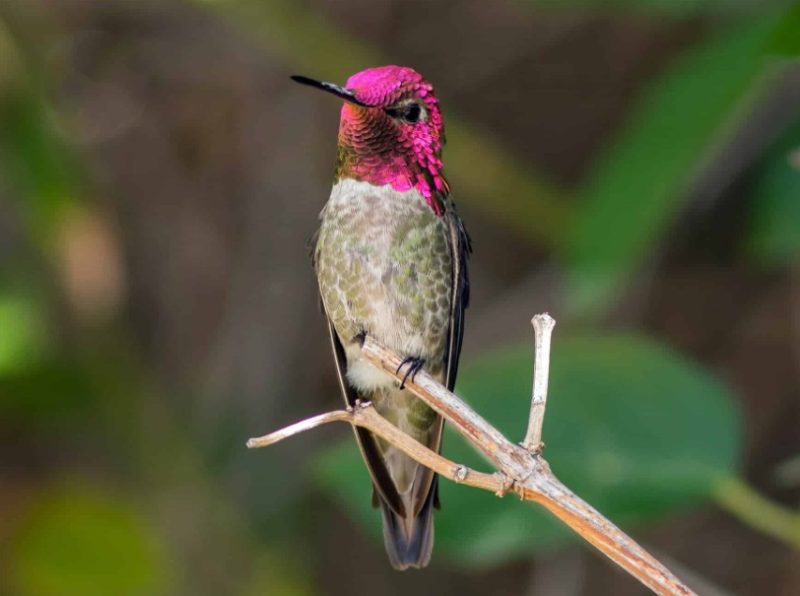
Anna’s Hummingbird is one of the few hummingbirds that can occasionally be seen in Colorado during the colder months. Males are striking, featuring a vivid rose-pink gorget and crown that sparkle in sunlight, while females have green backs and pale underparts with a faint reddish wash on the throat. Their iridescent colors shift with lighting, creating a dazzling display even in winter’s subdued tones.
This relatively large hummingbird measures about 4 inches in length, making it slightly bigger than most Colorado species. Its flight is direct and strong, with rapid wingbeats that allow it to hover motionless while feeding. Anna’s Hummingbirds are also known for their remarkable vocalizations—unlike most hummingbirds, they produce a series of metallic chirps and songs, particularly during courtship.
Although native to the Pacific Coast, Anna’s Hummingbirds are rare but regular visitors to Colorado, especially in the southern and eastern regions. They are sometimes recorded around Denver, Pueblo, and Colorado Springs during unusually warm winters or transitional migration periods. They tend to visit backyard feeders offering sugar water or late-blooming plants such as salvia and penstemon.
The best time to observe Anna’s Hummingbirds in Colorado is during late fall and early winter, when occasional stragglers wander eastward. These resilient birds can tolerate colder temperatures than most other hummingbird species, often remaining active even when frost appears on the ground. Each sighting of an Anna’s Hummingbird in Colorado is considered a special event for birdwatchers.
Costa’s Hummingbird (Calypte costae)
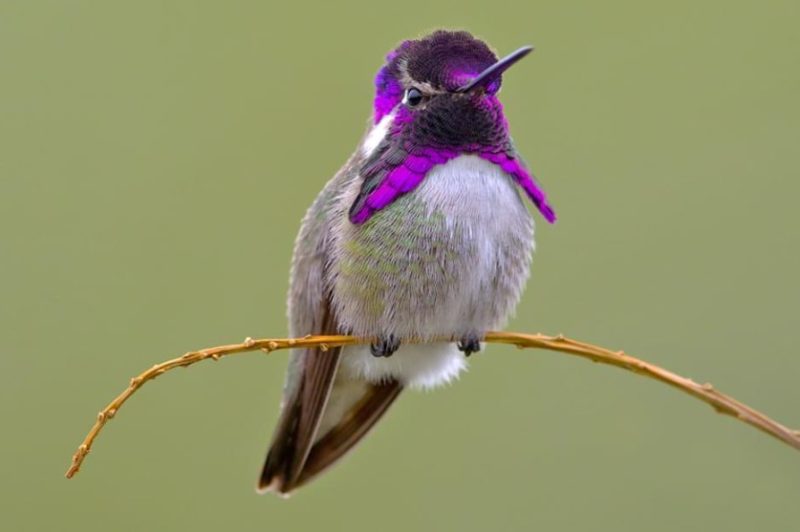
Costa’s Hummingbird is a dazzling yet rare visitor to Colorado, distinguished by its compact size and brilliant violet-purple gorget that extends out in long, flared feathers along the sides of the head. Males also display a matching violet crown and glossy green upperparts, while females are more subdued with grayish-white underparts and green backs. This flared gorget gives the male a unique helmet-like appearance that sets it apart from all other hummingbirds.
Measuring around 3 to 3.5 inches long, Costa’s Hummingbird is small but spirited, with a short, straight bill and a relatively short tail. Their flight is fast and direct, accompanied by high-pitched squeaks and trills. During courtship, males perform a series of looping dives, flashing their iridescent colors to impress females. They feed on nectar from desert flowers and supplement their diet with small insects for protein.
Although Costa’s Hummingbird primarily inhabits the arid deserts of the American Southwest — including Arizona, Nevada, and California — individuals occasionally wander into southern and western Colorado. These rare appearances often occur during spring and fall migration, when strong winds or weather shifts lead them slightly outside their normal range.
For birdwatchers in Colorado, spotting a Costa’s Hummingbird is an exciting event. The best chance to see one is during early spring or late summer in the Four Corners region, especially in areas near Grand Junction or the San Juan Mountains. Observations are sporadic, and each sighting is typically documented by local birding groups due to its rarity.
Ruby-throated Hummingbird (Archilochus colubris)
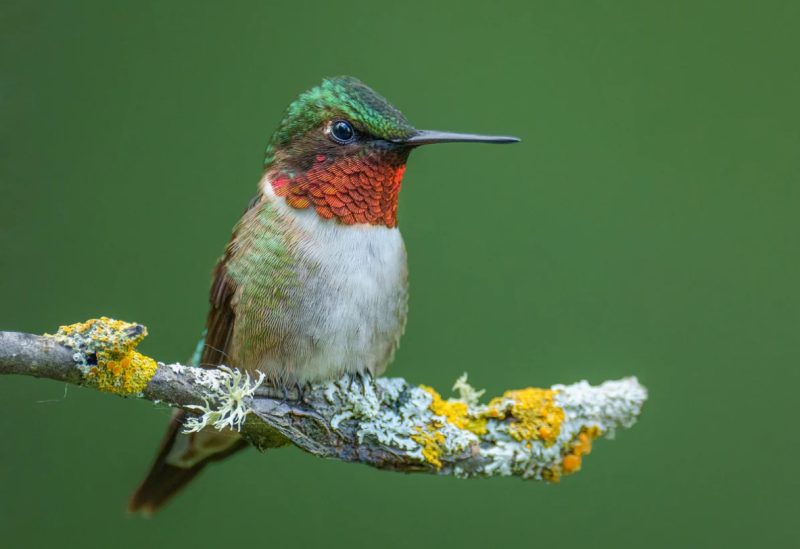
The Ruby-throated Hummingbird, famous throughout the eastern United States, is only a rare visitor to Colorado. Males are instantly recognizable by their glowing ruby-red gorget that appears black in shadow but flashes bright red in direct sunlight. Both sexes have metallic green upperparts, white underparts, and slender, straight bills ideal for nectar feeding. Females lack the red throat but share the same emerald sheen on the back.
This medium-sized hummingbird averages about 3.5 inches in length and has a rapid, agile flight pattern with distinctive hovering and darting movements. Males perform pendulum-shaped courtship flights accompanied by high-pitched wing hums. They are known for their endurance — capable of migrating more than 1,200 miles nonstop across the Gulf of Mexico, an incredible feat for such a tiny bird.
In Colorado, Ruby-throated Hummingbirds are mostly recorded in the eastern plains, particularly along riparian corridors and well-planted gardens. They are not common residents but instead occasional migrants that stray westward beyond their typical range. Reports are most frequent during late summer when juveniles and adults disperse after breeding season.
Birders seeking to spot this species should focus on eastern Colorado between June and August. Setting up feeders filled with a simple sugar-water mixture may attract these wayward travelers. While sightings are rare, each encounter provides a glimpse of a species more commonly associated with the lush woodlands of the eastern United States.
Lucifer Hummingbird (Calothorax lucifer)
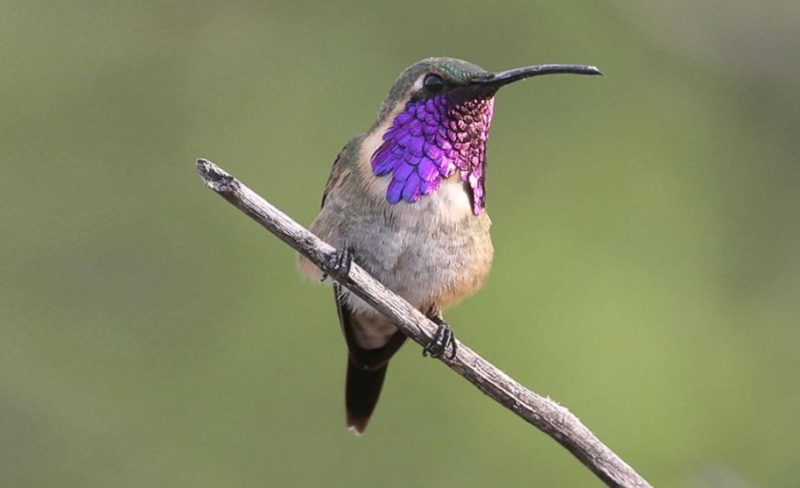
The Lucifer Hummingbird is one of the rarest hummingbird species ever recorded in Colorado. Males are unmistakable with their long, decurved bills and vivid, iridescent purple throats that shimmer against a contrasting green back and grayish underparts. Females are more subdued in color, showing greenish upperparts and pale underparts, but both sexes have noticeably curved bills suited for feeding on deep tubular flowers.
This hummingbird measures about 4 inches long and has a slender, elegant appearance. It often hovers in front of agave and ocotillo blossoms, inserting its long bill to reach nectar. Males are territorial, defending prime feeding areas with quick aerial chases and sharp, twittering calls. Their flight is strong and direct, making them well-suited for the open desert canyons they inhabit.
The Lucifer Hummingbird’s main range lies in northern Mexico and parts of southern Arizona, New Mexico, and Texas. However, a few have occasionally ventured into southern Colorado, especially near the state’s desert margins. Such sightings are extremely rare and generally occur during late summer or early fall migration.
For birdwatchers, spotting a Lucifer Hummingbird in Colorado is an extraordinary event. The best chances come from the far southern counties bordering New Mexico, where a few stray individuals have been documented in canyons and arid foothills. Each confirmed record adds to the limited knowledge of this elusive species’ occasional wanderings beyond its typical habitat.
Allen’s Hummingbird (Selasphorus sasin)
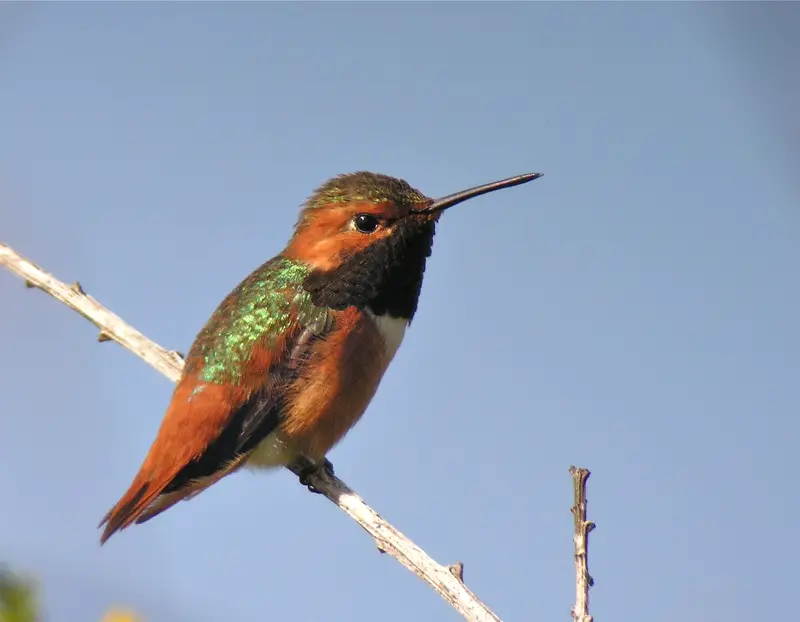
Allen’s Hummingbird is a coastal species native to California, known for its vivid coloration and fast, darting flight. Males are nearly identical to Rufous Hummingbirds, featuring bright orange flanks, green backs, and a shimmering reddish-orange gorget. The key distinguishing feature is the male’s narrower outer tail feathers and greener upperparts. Females have green backs, whitish underparts, and a hint of rufous on the flanks and tail.
At about 3.5 inches long, Allen’s Hummingbird is small but vibrant, with a high-energy flight style that includes frequent hovering and rapid, zigzag chases. Males perform dramatic courtship dives, producing loud trills with their wings. They are highly territorial and aggressive, often dominating feeders or flower patches during the breeding season.
Although primarily confined to coastal and chaparral regions of California and southern Oregon, Allen’s Hummingbirds occasionally wander eastward into Colorado. Most sightings occur during late summer or early fall, when juveniles disperse after breeding. These vagrant individuals are usually found in the western part of the state, particularly around mountain valleys and gardens near the Utah border.
Due to the difficulty of distinguishing Allen’s from Rufous Hummingbirds, every sighting in Colorado is carefully reviewed by state ornithologists. The best time to potentially observe one is from August to early September in western Colorado, though such encounters remain exceptionally rare and exciting for hummingbird enthusiasts.
Blue-throated Mountain-gem (Lampornis clemenciae)
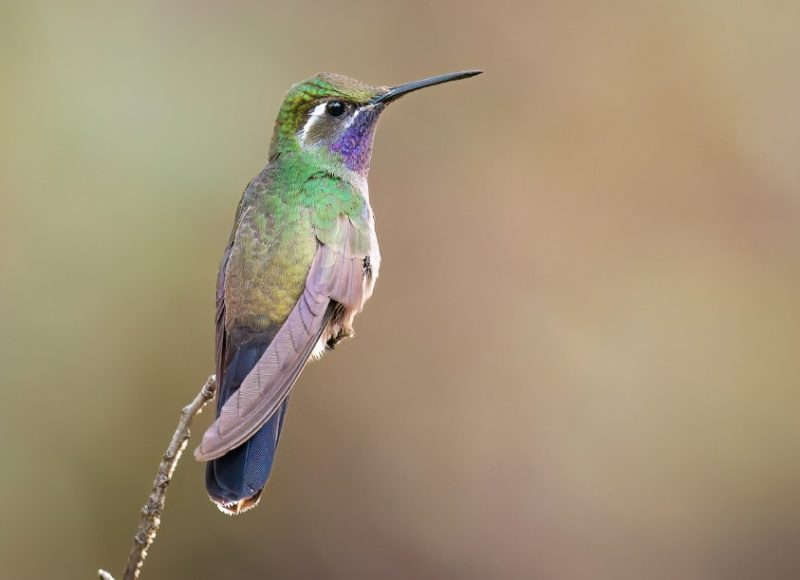
The Blue-throated Mountain-gem is the largest hummingbird likely to be seen in Colorado, reaching up to 5 inches in length. Males are stunning, with deep blue throats, metallic green backs, and bold white stripes running along the face and behind the eyes. Females share similar coloration but lack the intense blue throat patch, displaying more muted grayish underparts. Both sexes have broad wings and tails that make their flight appear more powerful than that of smaller hummingbirds.
Their flight produces a low, buzzing hum, and males often perch prominently while guarding feeding territories. Unlike many hummingbirds that rely solely on nectar, Blue-throated Mountain-gems frequently catch small insects in midair. They are also among the few species known to produce audible calls, including soft chips and trills.
In Colorado, this hummingbird is extremely uncommon, with most sightings occurring in the far southern regions near the New Mexico border. They inhabit shaded canyons, pine-oak forests, and mountain ravines, preferring areas with dense vegetation and a steady water source. These habitats closely resemble the ones they occupy more regularly in Mexico and the southwestern U.S.
The best time to spot a Blue-throated Mountain-gem in Colorado is late summer, typically in secluded canyon areas of the southern mountains. Because of their size and deep wing buzz, they are relatively easy to recognize once seen. Each appearance of this magnificent bird in the state adds to the allure of Colorado’s diverse hummingbird population.
Hummingbird Season in Colorado
When Do Hummingbirds Arrive and Leave Colorado
Hummingbird season in Colorado typically begins in late April, when the first Broad-tailed and Black-chinned Hummingbirds return from their wintering grounds in Mexico and Central America. By May, the mountains and foothills come alive with their whirring wings and shimmering colors. The peak season usually spans June through August, when flowers are in full bloom and feeders attract both local breeders and migrating visitors.
As summer fades, southbound migration begins in late August, with species like the Rufous and Calliope Hummingbirds passing through in large numbers. By mid-September, most hummingbirds have departed, although rare stragglers such as Anna’s Hummingbird may linger into early winter in milder southern areas. For birdwatchers, late July to early September offers the best chance to see multiple species at once across Colorado’s mountain meadows and foothills.
Best Places to See Hummingbirds in Colorado
Colorado offers a variety of excellent birding locations for hummingbird enthusiasts. The Rocky Mountain National Park, Mesa Verde National Park, and the San Juan Mountains are prime summer habitats for Broad-tailed and Calliope Hummingbirds. The Front Range foothills, from Boulder to Colorado Springs, host both Black-chinned and Rufous Hummingbirds at feeders and wildflower gardens.
In southwestern Colorado, canyons and riparian zones provide good opportunities for spotting rarer species such as Costa’s or Lucifer Hummingbirds. Urban and suburban gardens across Denver and Fort Collins also attract hummingbirds during migration, especially when well-stocked feeders are maintained throughout the summer.
What Time of Day is Best for Viewing
The best time of day to observe hummingbirds in Colorado is early morning and late afternoon, when they are most active and light conditions enhance the visibility of their iridescent plumage. Mornings are ideal for watching feeding behavior, while evenings are perfect for observing territorial displays and courtship flights. Midday activity usually declines as temperatures rise, especially in high-elevation areas.
Tips for Attracting Hummingbirds in Colorado
Choose the Right Feeders and Nectar
To attract hummingbirds, use red feeders with multiple feeding ports—the color red acts as a natural magnet for these birds. Fill feeders with a simple homemade nectar solution of four parts water to one part white sugar, avoiding dyes or artificial sweeteners. Always boil the water and let it cool before filling the feeder to ensure safety and cleanliness.
Change the nectar every two to three days in warm weather to prevent fermentation or mold growth. In cooler mountain climates, every four days may suffice. Keeping feeders clean and fresh is essential for maintaining hummingbird health and encouraging repeat visits throughout the season.
Add Native Flowers to Your Yard
Planting native flowering plants is one of the best ways to draw hummingbirds naturally. Colorado natives like columbine, penstemon, bee balm, and salvia provide abundant nectar and attract insects for additional food. Arrange flowers in clusters of bright colors—particularly reds, oranges, and pinks—to catch the birds’ attention from afar.
Combine early-, mid-, and late-season bloomers to create a continuous food source from spring through fall. This not only benefits hummingbirds but also supports other native pollinators such as bees and butterflies.
Provide Shelter and Water
In addition to nectar, hummingbirds seek safe resting spots and reliable water sources. Plant small trees and shrubs such as willow, serviceberry, or aspen to offer perches and nesting areas. Avoid using pesticides, as hummingbirds also feed on small insects for protein.
Add a misting fountain or shallow water dripper to create a gentle spray—hummingbirds enjoy bathing and drinking from moving water. Place it near feeders or flowers to make your yard more appealing and functional as a complete habitat.
FAQs about Colorado Hummingbirds
How Many Species of Hummingbirds Live in Colorado?
Colorado hosts around 10 species of hummingbirds, including common residents like the Broad-tailed and Black-chinned Hummingbirds, and several rare or migratory visitors such as the Rufous, Calliope, and Costa’s Hummingbirds. Some, like the Anna’s and Blue-throated Mountain-gem, appear only occasionally but add to the state’s rich hummingbird diversity.
Do Hummingbirds Nest in Colorado?
Yes, several species nest in Colorado. The Broad-tailed Hummingbird is the most widespread breeder, especially in mountain regions between 6,000 and 10,000 feet. Females construct small cup-shaped nests using spider silk, plant down, and lichens, attaching them to slender branches or aspen twigs. Calliope and Black-chinned Hummingbirds also nest in the state, typically in forest edges and canyon habitats.
When Should I Take Down My Feeders in Colorado?
It’s recommended to keep feeders up until mid-October. Some hummingbirds migrate later than others, and providing nectar ensures that late travelers or stragglers have energy for their long journey south. Removing feeders too early may deprive these birds of a vital food source during migration.
Can Hummingbirds Survive the Colorado Winter?
Most hummingbirds migrate south for winter, but on rare occasions, Anna’s Hummingbirds have overwintered in southern or urban areas of Colorado during mild years. These birds rely on heated feeders and consistent nectar sources. Generally, by November, nearly all hummingbirds have departed for warmer regions in Mexico or Central America.
What Flowers Attract Hummingbirds the Most in Colorado?
Some of the best flowers for attracting hummingbirds in Colorado include red columbine, bee balm, trumpet vine, penstemon, salvia, and scarlet gilia. These tubular flowers produce abundant nectar and bloom during peak hummingbird season. Mixing these plants in sunlit garden beds ensures continuous activity throughout the summer months.

